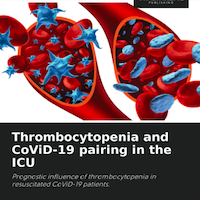Tag: pneumonia
Relationship between Concentrations of Oxygen and Levels of Oxidative Stress in Patients Receiving Oxygen Therapy for Severe COVID-19 Pneumonia
We evaluated the potential of high-flow oxygen therapy to increase oxidative stress and inflammation in COVID-19 patients. Our observation of decreased MDA levels when transitioning hypertensive patients from high-flow to... read more
Preventing VAP Non-Pharmacologically
In critically ill, intubated patients on intensive care unit (ICU), ventilator-associated pneumonia (VAP) is a significant complication contributing to substantial mortality, morbidity, and prolonged stays, which in turn... read more
Management of Refractory COPD
Chronic obstructive pulmonary disease (COPD) is a common condition with an estimated global prevalence of almost 12 percent in adults over age 30 years [1-3]. Prior to the onset of the COVID-19 (coronavirus disease 2019)... read more
Microbial Dynamics and Pulmonary Immune Responses in COVID-19 Secondary Bacterial Pneumonia
Secondary bacterial pneumonia (2°BP) is associated with significant morbidity following respiratory viral infection, yet remains incompletely understood. In a prospective cohort of 112 critically ill adults intubated... read more
Outcomes and inflammation changes in different types of immunocompromised patients with critically ill COVID-19 admitted to ICU
Critically ill COVID-19 patients admitted to the ICU exhibit distinct clinical outcomes based on their immunosuppression status, with cancer patients facing the highest mortality rate due to variations in inflammatory responses... read more
Thrombocytopenia and COVID-19 pairing in the ICU: Prognostic influence of thrombocytopenia in resuscitated CoViD-19 patients
CoViD-19 is a viral zoonosis caused by the coronavirus strain (SARS-CoV-2), with acute respiratory failure being its most severe manifestation. Our aim was to determine the influence of thrombocytopenia on the severity and... read more

Blood Eosinophils Matter in Post-COVID-19 Pneumonia
Preliminary results showed that a eosinophil increase during hospitalization could be a potential predictor of pulmonary sequelae in surviving patients after COVID-19 pneumonia. Despite the protective role of eosinophils,... read more
COVID-19 Pneumonia: Different Respiratory Treatments for Different Phenotypes?
Type L and Type H patients are best identified by CT scan and are affected by different pathophysiological mechanisms. If not available, signs which are implicit in Type L and Type H definition could be used as surrogates:... read more
CDC Reports Rising Levels of Mycoplasma Pneumonia and RSV in Young Kids
Though the nation’s respiratory disease levels remain low overall, with COVID levels declining and little sign of a flu uptick, illnesses caused by Mycobacterium pneumoniae are increasing, especially in children, and respiratory... read more
Predictive Value of Diaphragm and Lung Ultrasonography for Weaning Failure in Critically Ill Patients with ARF Due to COVID-19 Pneumonia
Patients undergoing mechanical ventilation due to respiratory failure require a comprehensive approach to determine the optimal timing for weaning from ventilatory support. Evaluating respiratory mechanics, maximal muscle... read more
VAP Prevention in the ICU
Critically ill patients admitted to an intensive care unit for a life-threatening condition (both medical and surgical) can contract a ventilator-associated pneumonia (VAP). This is an infection acquired by virtue of... read more
Adiposity and Mortality Among ICU Patients with COVID-19 and Non-COVID-19 Respiratory Conditions
Obesity is associated with higher mortality among COVID-19 patients, but lower mortality among non-COVID-19 respiratory patients. These associations appear vulnerable to confounding/selection bias in both patient groups,... read more
Impact of the Timing of Invasive Mechanical Ventilation in Sepsis Patients
In patients with sepsis admitted to ICU and received invasive mechanical ventilation (MV), early MV was associated with lower ICU and in-hospital mortality and a shorter ICU stay. Additionally, at ICU discharge, early... read more
Optimal Antibiotic Treatment Duration of Upper and Lower Respiratory Tract Infections
The available evidence for non-ICU community-acquired pneumonia (CAP) and chronic obstructive pulmonary disease (AECOPD) supports a short-course treatment duration of 5 days in patients who have clinically improved. Efforts... read more
Outcomes of Different Steroid Dosing Regimens in Critical Covid-19 Pneumonia
The study found that high-dose steroids in the treatment of critically ill patients with COVID-19 pneumonia did not confer any mortality benefit and were associated with an increased risk of dysglycemia and superimposed infections. A... read more
Can Clinicians Identify CAP on Ultralow-dose CT?
This study found that clinicians could assess chest ULD-CTs for community-acquired pneumonia (CAP) with high, but not perfect, diagnostic accuracy using an ED radiologist’s assessments as reference standard. Interrater... read more
Trends in Empiric Broad-Spectrum Antibiotic Use for Suspected Community-Onset Sepsis in US Hospitals
Empiric treatment for suspected community-onset sepsis accounts for about half of broad-spectrum antibiotic use in US hospitals even though resistant organisms are isolated in only 7% of patients with community-onset sepsis... read more
Secretomic Approach Value in COVID-19 Viral Pneumonia Among Patients With Respiratory Distress
this article presents an innovative and promising secretomic analysis to distinguish VPP patients from NV-ICU patients using combinations of protein markers. Among the identified proteins, ficolin-3 and proteoglycan-4 appear... read more
The Existence of Adrenal Insufficiency in COVID-19 Patients with Pneumonia
Patients with a history of COVID-19 pneumonia who present with clinical symptoms such as shock, nausea, vomiting, and fatigue should have hypocortisolism included in the differential diagnosis. These patients should also... read more
Predictive Value of Multiple Scoring Systems in the Prognosis of Septic Patients with Different Infection Sites
The heterogeneity nature of sepsis is significantly impacted by the site of infection. This study aims to explore the predictive value of multiple scoring systems in assessing the prognosis of septic patients across different... read more
Secretomic Approach Value for Distinguishing Patients with COVID-19 Viral Pneumonia Among ICU Patients with Respiratory Distress
In intensive care units, COVID-19 viral pneumonia patients (VPP) present symptoms similar to those of other patients with Nonviral infection (NV-ICU). To better manage VPP, it is therefore interesting to better understand... read more
Risk Factors of Post-intubation Hypotension in Severe Pneumonia Patients
Post-intubation hypotension (PIH) was one of the serious complications after Endotracheal intubation (ETI) in Severe pneumonia (SP) patients. The risk factors of PIH were investigated in SP patients to provide a theoretical... read more









